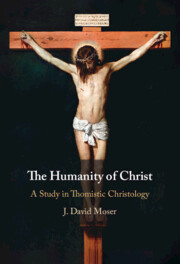Refine search
Actions for selected content:
149 results
13 - Incarnation
- from Part II - Theological Themes
-
-
- Book:
- The Origins of Scholasticism
- Published online:
- 18 November 2025
- Print publication:
- 08 January 2026, pp 361-387
-
- Chapter
- Export citation
Redeeming metaphysics in light of René Girard’s Christology
-
- Journal:
- Scottish Journal of Theology , First View
- Published online by Cambridge University Press:
- 27 November 2025, pp. 1-15
-
- Article
- Export citation
5 - Theological Themes
- from Part II - The World of the Text
-
- Book:
- The Gospel of Truth
- Published online:
- 23 October 2025
- Print publication:
- 06 November 2025, pp 106-138
-
- Chapter
- Export citation
20 - Christology and Political Theology
- from Part IIIb - Christology and Philosophical Theology
-
-
- Book:
- The Cambridge Companion to Christology
- Published online:
- 15 September 2025
- Print publication:
- 02 October 2025, pp 340-358
-
- Chapter
- Export citation
19 - Christology and Holiness
- from Part IIIb - Christology and Philosophical Theology
-
-
- Book:
- The Cambridge Companion to Christology
- Published online:
- 15 September 2025
- Print publication:
- 02 October 2025, pp 323-339
-
- Chapter
- Export citation
8 - Modern and Postmodern Receptions
- from Part II - The Christological Reception
-
-
- Book:
- The Cambridge Companion to Christology
- Published online:
- 15 September 2025
- Print publication:
- 02 October 2025, pp 127-144
-
- Chapter
- Export citation
15 - Christology and Pneumatology
- from Part IIIa - Christology and Systematic Theology
-
-
- Book:
- The Cambridge Companion to Christology
- Published online:
- 15 September 2025
- Print publication:
- 02 October 2025, pp 251-267
-
- Chapter
- Export citation
18 - Christology and Consistency
- from Part IIIb - Christology and Philosophical Theology
-
-
- Book:
- The Cambridge Companion to Christology
- Published online:
- 15 September 2025
- Print publication:
- 02 October 2025, pp 305-322
-
- Chapter
- Export citation
17 - Christology and Metaphysics
- from Part IIIb - Christology and Philosophical Theology
-
-
- Book:
- The Cambridge Companion to Christology
- Published online:
- 15 September 2025
- Print publication:
- 02 October 2025, pp 287-304
-
- Chapter
- Export citation
13 - Christology and the Atonement
- from Part IIIa - Christology and Systematic Theology
-
-
- Book:
- The Cambridge Companion to Christology
- Published online:
- 15 September 2025
- Print publication:
- 02 October 2025, pp 219-233
-
- Chapter
- Export citation
Introduction
-
-
- Book:
- The Cambridge Companion to Christology
- Published online:
- 15 September 2025
- Print publication:
- 02 October 2025, pp 1-6
-
- Chapter
- Export citation
4 - Dubia, Part 1
- from Part II - Difficulties and Resolutions
-
- Book:
- The Humanity of Christ as Instrument of Salvation
- Published online:
- 21 August 2025
- Print publication:
- 04 September 2025, pp 123-150
-
- Chapter
- Export citation
5 - Dubia, Part 2
- from Part II - Difficulties and Resolutions
-
- Book:
- The Humanity of Christ as Instrument of Salvation
- Published online:
- 21 August 2025
- Print publication:
- 04 September 2025, pp 151-172
-
- Chapter
- Export citation

The Humanity of Christ as Instrument of Salvation
- A Study in Thomistic Christology
-
- Published online:
- 21 August 2025
- Print publication:
- 04 September 2025
8 - Arianism and Other Christological Disputes
- from Part II - Case Studies
-
-
- Book:
- The Cambridge Companion to Christian Heresy
- Published online:
- 17 July 2025
- Print publication:
- 31 July 2025, pp 156-174
-
- Chapter
- Export citation
15 - Preaching on Life as a Pilgrimage
- from Part III - Augustine’s Preaching Themes
-
-
- Book:
- The Cambridge Companion to Augustine's Sermons
- Published online:
- 26 May 2025
- Print publication:
- 12 June 2025, pp 281-298
-
- Chapter
- Export citation
7 - Sermons for Lent, Good Friday, and Easter
- from Part II - Augustine’s Sermons on the Scriptures and Liturgical Feasts
-
-
- Book:
- The Cambridge Companion to Augustine's Sermons
- Published online:
- 26 May 2025
- Print publication:
- 12 June 2025, pp 133-151
-
- Chapter
- Export citation
8 - Sermons on the Ascension and Pentecost
- from Part II - Augustine’s Sermons on the Scriptures and Liturgical Feasts
-
-
- Book:
- The Cambridge Companion to Augustine's Sermons
- Published online:
- 26 May 2025
- Print publication:
- 12 June 2025, pp 152-168
-
- Chapter
- Export citation
Confessio Trinitatis and theological polemic in Ambrose of Milan’s ‘Splendor paternae gloriae’
-
- Journal:
- Scottish Journal of Theology / Volume 78 / Issue 2 / May 2025
- Published online by Cambridge University Press:
- 15 May 2025, pp. 138-151
- Print publication:
- May 2025
-
- Article
- Export citation
How to read ambiguity well: Reading ambiguity in Luke and Acts
-
- Journal:
- Scottish Journal of Theology / Volume 78 / Issue 2 / May 2025
- Published online by Cambridge University Press:
- 07 April 2025, pp. 91-103
- Print publication:
- May 2025
-
- Article
-
- You have access
- Open access
- HTML
- Export citation
